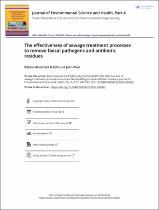| dc.contributor.author | Hendricks, Rahzia | |
| dc.contributor.author | Pool, Edmund John | |
| dc.date.accessioned | 2023-02-28T10:22:12Z | |
| dc.date.available | 2023-02-28T10:22:12Z | |
| dc.date.issued | 2013 | |
| dc.identifier.citation | Hendricks, R., & Pool, E. J. (2023). The effectiveness of sewage treatment processes to remove faecal pathogens and antibiotic residues. Journal of Environmental Science and Health, Part A: Toxic/Hazardous Substances and Environmental Engineering, 47 (2) , 289-297. https://doi.org/10.1080/10934529.2012.637432 | en_US |
| dc.identifier.issn | 1532-4117 | |
| dc.identifier.uri | https://doi.org/10.1080/10934529.2012.637432 | |
| dc.identifier.uri | http://hdl.handle.net/10566/8476 | |
| dc.description.abstract | Pathogens and antibiotics enter the aquatic environment via sewage effluents and may pose a health risk to wild life and humans.The aim of this study was to determine the levels of faecal bacteria, and selected antibiotic residues in raw wastewater and treatedsewage effluents from three different sewage treatment plants in the Western Cape, South Africa. Sewage treatment plant 1 and 2 useolder technologies, while sewage treatment plant 3 has been upgraded and membrane technologies were incorporated in the treatmentprocesses. Coliforms andEscherichia coli(E. coli) were used as bioindicators for faecal bacteria. A chromogenic test was used toscreen for coliforms andE. coli. Fluoroquinolones and sulfamethoxazole are commonly used antibiotics and were selected to monitorthe efficiency of sewage treatment processes for antibiotic removal. Enzyme Linked Immunosorbent Assays (ELISAs) were used toquantitate antibiotic residues in raw and treated sewage. Raw intake water at all treatment plants contained total coliforms andE. coli.High removal ofE. coliby treatment processes was evident for treatment plant 2 and 3 only. Fluoroquinolones and sulfamethoxazolewere detected in raw wastewater from all sewage treatment plants. Treatment processes at plant 1 did not reduce the fluoroquinoloneconcentration in treated sewage effluents. Treatment processes at plant 2 and 3 reduced the fluoroquinolone concentration by 21%and 31%, respectively. Treatment processes at plant 1 did not reduce the sulfamethoxazole concentration in treated sewage effluents. Treatment processes at plant 2 and 3 reduced sulfamethoxazole by 34% and 56%, respectively. This study showed that bacteria and antibiotic residues are still discharged into the environment. Further research needs to be undertaken to improve sewage treatmenttechnologies, thereby producing a better quality treated sewage effluent. | en_US |
| dc.language.iso | en | en_US |
| dc.publisher | TAYLOR & FRANCIS INC | en_US |
| dc.subject | Pathogens | en_US |
| dc.subject | Wildlife | en_US |
| dc.subject | Bioscience | en_US |
| dc.subject | Water pollution | en_US |
| dc.subject | Western Cape | en_US |
| dc.title | The effectiveness of sewage treatment processes to remove faecal pathogens and antibiotic residues | en_US |
| dc.type | Article | en_US |

